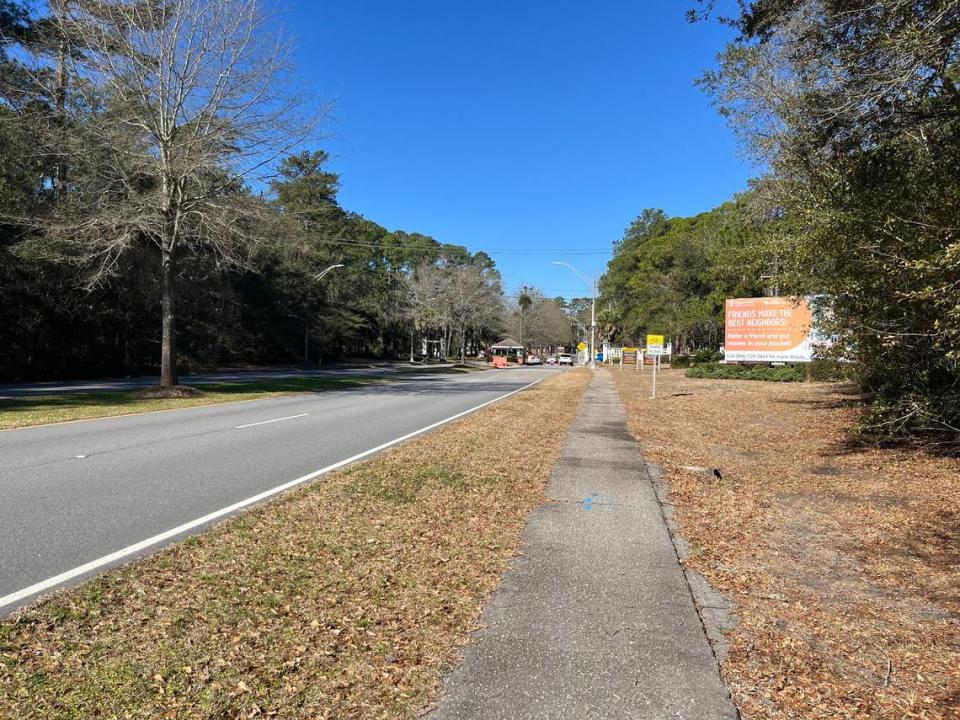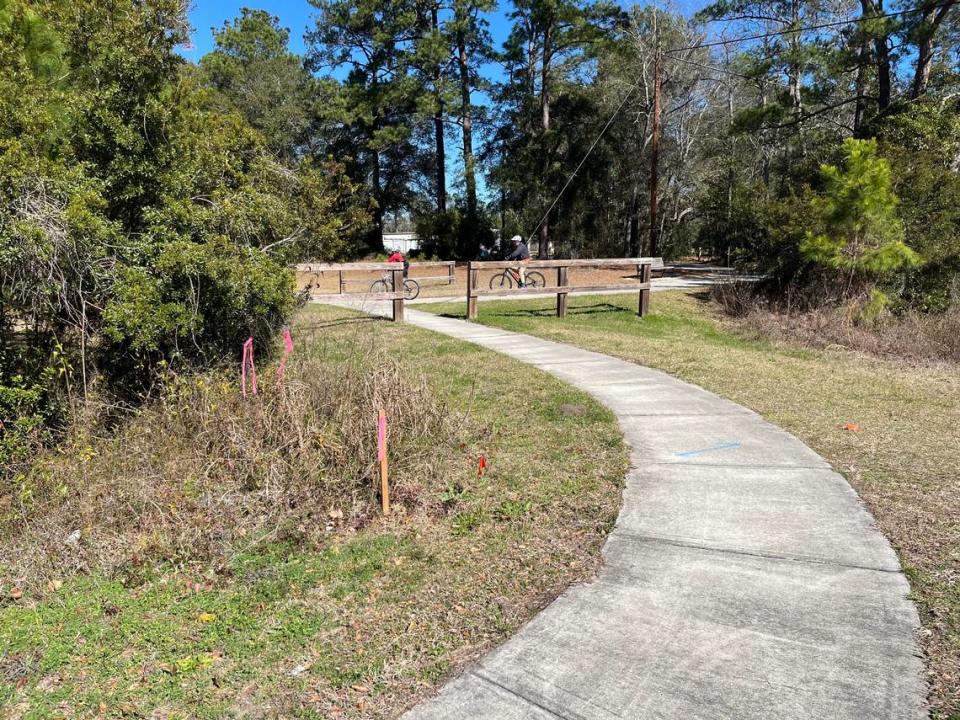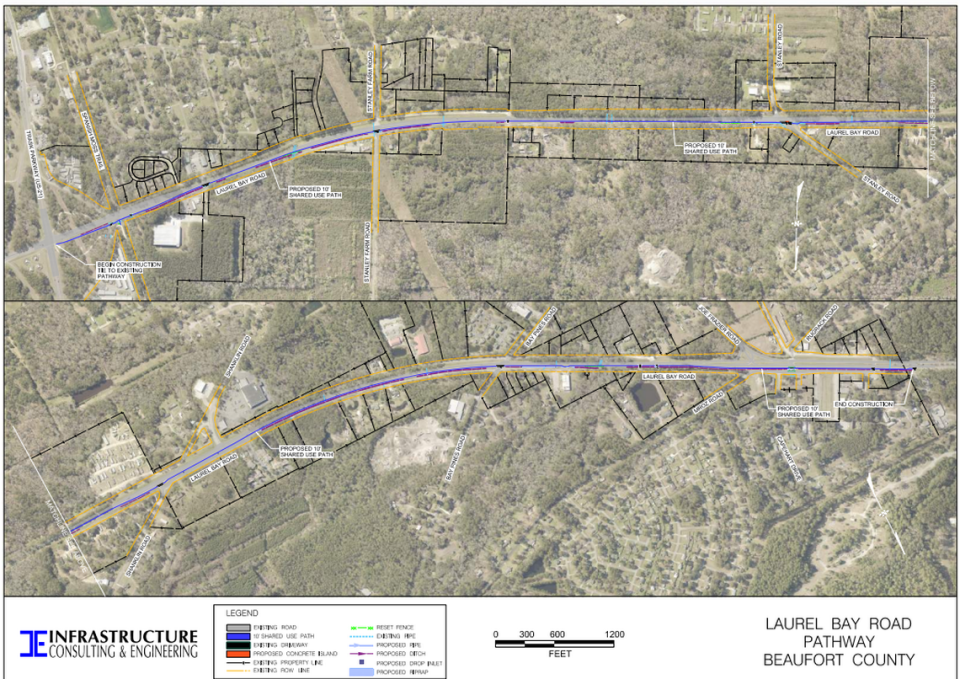Building a new walking path near Beaufort will cost $1.4M per mile. Who is paying for it?
Beaufort County is planning to spend $4.9 million to rebuild and improve a 3.5-mile bike and pedestrian path along Laurel Bay Road north of Beaufort using state and county penny tax funds. The $1.4 million-per-mile cost is raising eyebrows but the head of the county’s engineering department says he’s not surprised because of skyrocketing construction costs in recent years.
Funding for the project is coming from a pair of sources including a grant from the state’s Department of Veterans Affairs and the county’s penny tax fund.
The project involves ripping out an aging 5-foot-wide path and building a new 10-foot-wide concrete path on the north side of Laurel Bay Road. It will stretch 3.5 miles, from U.S. Highway 21 (Trask Parkway) to the Laurel Bay Military Housing Complex, making it one of the longest public pathways in the county. Construction is scheduled to get underway this week.
Beaufort County is warning motorists to prepare for minor traffic delays during the 8-month-long project.
When the project was out for public comment last spring, its cost and use of taxpayer money for the work was brought into question by some residents.
“I live and work at the intersection of Laurel Bay Road and Stanley Road and have been there for ten years,” one person wrote to the county. “I hardly ever see pedestrians or bicyclists using the existing asphalt path and can’t imagine this lack of use is resulting from a poor quality pathway. I’m sure your intentions are good but I just can’t see that this would be a good use of $100,000 let alone millions. This money is being taxed from the pockets of hard working citizens. If you are going to tax us for infrastructure projects, please find projects that are worthwhile and beneficial to those taxpayers.”

What’s driving the cost?
Jared Fralix, who heads the county’s engineering department, acknowledged the high cost, but added, “everything is expensive now.” Inflation and the rising cost of materials and labor and a strong construction market are all factors in the higher costs, he said.
Costs have gotten so high, Fralix added, that county engineers are not even surprised anymore when bids come in “because everything comes in high.” It’s been that way for the past few years, he says. Construction estimates as recent as six months to a year ago do not mean “that’s the cost of doing business today,” Fralix said. “We’re not shocked because we’ve been seeing this but it does definitely cost more than it was previously.”
Of the 10 comments the county received on the Laurel Bay project, four people were against the project but six people spoke in favor.
Several of the pro-path comments expressed safety concerns because of speeding motorists and even the need for more protections including crosswalks and crossing lights.
“I live on Laurel Bay Road and to me this project would only enhance an already volatile area,” one resident wrote. “Laurel Bay Road has become a high speed area. “
The Marine Corps Air Station supports the project, according to Beaufort County.
How it’s being paid for
A military enhancement grant from the South Carolina Department of Veterans Affairs is covering 80 percent, or $3,392,328, of the project cost. That agency is involved because the project would benefit Marines living at military housing at Laurel Bay, which is across Trask Parkway from Marine Corps Air Station Beaufort.
The County Council voted to accept that state grant Monday.
“The fact we have 80 percent match on one of the largest pathway projects is pretty significant,” Fralix said.
The county will contribute $1,558,612 toward the effort. Those funds will come from penny sales tax that voters OK’d in 2018 to raise $120 million for road and pathway work across Beaufort County.
That brings the total cost of the Laurel Bay work to $4.9 million. The total includes an $825,000 contingency that would only be used if unforeseen issues come up like change orders or utility challenges. The $4.2 million construction contract was awarded to IPW Construction Group, which was one of two contractors to submit bids.
In its report to the County Council, Beaufort County staff said that the county should proceed with the work based on the public comments it received and the $3.4 million state Veterans’ Affairs grant, which came from a “military enhancement fund.”
“The concept behind this fund and grant opportunity is to enhance the quality of life, where it is specific to the military or the community around the military,” Fralix said.
The Laurel Bay Road pathway will be used by residents of the base housing and civilians who in the Laurel Bay area. It will also connect with the Spanish Moss Trail near Trask Parkway.

It is one of the 24 locations approved for pathway work in the 2018 penny tax referendum, which raised money for three main project areas: $80 Million for U.S. 278 corridor traffic Improvement, $30 Million for Lady’s Island corridor traffic improvements and $10 million for sidewalks and multi-use pathways.
A couple of those pathway projects are done. The rest are in various stages of design or construction.
Fralix says the Laurel Bay Road pathway is part of a larger effort to increase pedestrian and bike-friendly paths, adding, “This pathway will help provide a safe and efficient route for both daily commutes and recreational activities”
The public pathway, the county adds, will seamlessly connect Laurel Bay Housing to the Marine Corps Air Station, creating a convenient route for residents, personnel and those utilizing the trail for recreational activities.

Traffic will be affected
Work will be conducted between 6 a.m. and 8 p.m., Monday through Saturday, Beaufort County said.
Portions of either lane and sections of the road shoulders will be closed intermittently throughout the project, the county said.
The ramp coming off Trask Highway southbound onto Laurel Bay Road will be permanently closed beginning Thursday. Anyone turning right will have to do so at the light.

